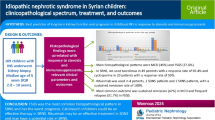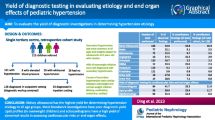Abstract
Introduction
Tuberous sclerosis complex (TSC) involves frequently the kidneys. Lesions encompass mainly angiomyolipoma and cysts. The disease can be associated with autosomal dominant polycystic kidney disease leading to the contiguous gene syndrome (CGS) The objectives of the present study were to review the US appearances of the renal involvement in children affected by classical TSC or by the CGS and to verify whether it is possible to differentiate between both entities. The evolution of the lesions through time was also studied.
Materials and methods
55 cases of patients <16 years with STB were reviewed by two pediatric radiologists. Clinical data reviewed included age at diagnosis, genetic assessment and complications; US data reviewed included renal size, type of lesions (angiomyolipoma—AML, or cysts), number and location as well as their evolution with time. Complications were also analyzed.
Results
30 patients (56 %) had at least one kidney lesion (27 classical TSC and 3 CGS). On the basis of the US findings, these patients were separated into four groups. Group 1 (9 patients) displayed microscopic (diffuse) AML; group 2 (3 patients) displayed macroscopic AML; group 3 (9 patients) displayed only renal cysts and group 4 (9 patients) displayed the association of AML and cysts. Increased renal size, the large number and size of cystic lesions were suggestive of the CGS. The isolated AML were suggestive of classical STB. The average growth of angiomyolipoma was low before age of 12 and exceeded 4 mm/year thereafter.
Conclusion
In children with TSC, renal involvement is common. Some US criteria can help to suggest the diagnosis of CGS. The growth of angiomyolipoma is slow before 12 years and accelerates thereafter. Complications are rare.





Similar content being viewed by others
Abbreviations
- TSC:
-
Tuberous sclerosis complex
- CGS:
-
Contiguous gene syndrome
- ADPKD:
-
Autosomal dominant polycystic kidneys disease
- AML:
-
Angiomyolipoma
- US:
-
Ultrasound
- PACS:
-
Picture archiving and communication system
- CMD:
-
Cortico-medullary differentiation
References
Curatolo P, Bombardieri R, Jozwiak S (2008) Tuberous sclerosis. Lancet 372:657–668
Van Slegtenhorst M, De Hoogt R, Hermans C et al (1997) Identification of the tuberous sclerosis gene TSC1 on Chromosome 9q34. Science 277:805–808
The european chromosome 16 tuberous sclerosis consortium (1993) Identification and characterization of the tuberous sclerosis gene on chromosome 16. Cell 75:1305–1315
Torra R, Badenas C, Darnell A et al (1998) Facilitated diagnosis of the contiguous gene syndrome: tuberous sclerosis and polycystic kidneys by means of haplotype studies. Am J Kidney Dis 31:1038–1043
OyazatoY Iijima K, Emi M et al (2011) Molecular analysis of TSC2/PKD1 contiguous gene deletion syndrome. Kobe J Med Sci 57:e1–e10
Ewalt D, Sheffield E, Sparagana S et al (1998) Renal lesion growth in children with tuberous sclerosis complex. J Urol 160:141–145
Rakowski SK, Winterkorn EB, Paul E et al (2006) Renal manifestations of tuberous sclerosis complex: incidence, prognosis, and predictive factors. Kidney Int 70:1777–1782
Shepherd CW, Gomez MR, Lie JT et al (1991) Causes of death in patients with tuberous sclerosis. Mayo Clin Proc 66:792–796
Hoyer PF (2015) Clinical manifestations of autosomal recessive polycystic kidney disease. Curr Opin Pediatr 27:186–192
Lendvay T, Marshall F (2003) The tuberous sclerosis complex and its highly variable manifestations. J Urol 169:1635–1642
Kang SK, Chandarana H (2012) Contemporary imaging of the renal mass. Urol Clin North Am 39:161–170
Halpenny D, Snow A, McNeill G et al (2010) The radiological diagnosis and treatment of renal angiomyolipoma-current status. Clin Radiol 65:98–102
El-Esawy S, Abou El-Ghar M, Gaballa G et al (2009) Characterization of solid renal masses using 64-slice multidetector CT Scanner. Sci world J 9:441–448
Pirson Y (2014) Kanaan N (2015) Infectious complications in autosomal dominant polycystic kidney disease. Nephrol Ther 11:73–77. doi:10.1016/jnehrol.11.008
Back SJ, Andronikou S, Kilborn T et al (2015) Imaging features of tuberous sclerosis complex with autosomal dominant polycystic kidney disease: a contiguous gene syndrome. Pediatr Radiol 45:386–395. doi:10.1007/s00247-014-3147-1
Cook J, Oliver K, Mueller R et al (1996) A cross sectional study of renal involvement in tuberous sclerosis. J Med Genet 33:480–484
Dixona B, Hulbertb J, Bisslera J (2011) Tuberous sclerosis complex renal disease. Nephron Exp Nephrol 118:e15–e20. doi:10.1159/000320891
Tran LH, Zupanc ML (2015) Long-term everolimus treatment in individuals with tuberous sclerosis complex: a review of the current literature. Pediatr Neurol 53:23–30. doi:10.1016/j.pediatrneurol.2014.10.024
Moavero R, Coniglio A, Garaci F et al (2013) Is mTOR inhibition a systemic treatment for tuberous sclerosis? Ital J Pediatr 17(39):57
Castagnetti M, Vezzù B, Laverda A et al (2007) Urological counseling and followup in pediatric tuberous sclerosis complex. J Urol 178:2155–2159
Eble JN (1998) Angiomyolipoma of kidney. Semin Diagn Pathol 15:21–40
Author information
Authors and Affiliations
Corresponding author
Ethics declarations
Conflict of interest
The authors declare that they have no conflict of interest.
Ethical standard
This article does not contain any studies with animals performed by any of the authors.
Informed consent
For this type of study formal consent is not required.
Rights and permissions
About this article
Cite this article
Robert, A., Leroy, V., Riquet, A. et al. Renal involvement in tuberous sclerosis complex with emphasis on cystic lesions. Radiol med 121, 402–408 (2016). https://doi.org/10.1007/s11547-015-0572-7
Received:
Accepted:
Published:
Issue Date:
DOI: https://doi.org/10.1007/s11547-015-0572-7




